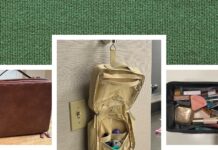Trump — who also instructed Americans on video not to “be afraid” of the coronavirus that has killed over 209,000 people in the United States or “let it dominate your life” — isn’t exactly in isolation. While many political staffers are working from home since more than a dozen White House officials tested positive in recent days (and turned the West Wing into a “total ghost town” in the words of one aide), there is an entire staff of people who work in the residence and do not have that option, from housekeepers to cooks and valets.
Trump’s immediate snub of safety guidelines is sure to increase concern about the safety of the residence staff now helping tend to their second active coronavirus patient, as Melania Trump is also resting at home. The White House has disclosed few details on how they’d be handling the president’s return to the residence — and how they’d be protecting the resident staff members, who are largely Black and Latino and often elderly, from contracting the virus.
- A White House staffer familiar with residence operations described a sense of inevitability that the president and first lady would eventually contract the virus due to lax precautions: “It was kind of preordained that [they] would get it because they do go around without masks — coronavirus is real.”
- The staffer noted the difference between that attitude and the strict measures that staff take to protect themselves and the first family: “We [the staff] would not have anyone there having coronavirus — they would be quarantined,” the source told us. “It’s taken a lot more serious because it is the White House and it’s close quarters. So it’s extremely scrutinized because of that. Everything we do is very controlled.”
- The risk is real: Two housekeepers tested positive for the virus weeks ago who “worked for the housekeeping department on the third floor, and didn’t come in direct contact with the first family,” the New York Times’s Maggie Haberman reports. They were asked to use “discretion” when discussing their positive diagnosis.
A White House spokesperson told Power Up that all staff, including support staff, received updated guidance from the operations office about additional precautions to take during the pandemic, and that “supplementary guidance” has been added as needed.
But the U.S. General Services Administration, the Office of Personnel Management, the first lady’s office, and the White House press office did not respond to request for more concrete details – including about whether the residence staff will be provided with additional personal protective equipment that doctors say is necessary to minimize their exposure to the virus. “In consultation with the White House Medical Unit, all precautions are being taken to ensure the health and safety of the residence staff,” Stephanie Grisham, the communications director for the first lady, told Power Up.
It’s also unclear what extra precautions Trump, known to eschew his own government’s guidance to minimize the spread, will be taking: The Diplomatic Reception Room and Map Room are being prepared for working spaces for Trump at the White House, White House aides told our colleagues Toluse Olorunnipa and Josh Dawsey. “But advisers said Mr. Trump wanted to demonstrate from the Oval Office that he was back and healthy, and they were unsure if they could prevent that,” per the New York Times’s Peter Baker and Maggie Haberman.
- “Even if the president and first lady stay confined upstairs, there is risk of exposure throughout the building, because White House political staffers, who have routinely not been wearing masks, often pass through the Rose Garden and the historical rooms on the first floor — all of which are manned by residence staffers,” per The Post’s Jada Yuan.
Trump’s medical team says it sent over safety recommendations, but his return will be a contrast from the full-scale medical environment at Walter Reed. “So the president has been surrounded by medical and security staff for days wearing full PPE,” White House physician Sean Conley told reporters earlier on Monday in defense of the president’s decision to leave the hospital in an SUV with Secret Service agents to greet supporters gathered outside. “The U.S. Secret Service agents were in that same level of PPE for a very short period of time. We’ve worked with our infectious-disease experts to make some recommendations for how to keep everything safe down at the White House, for the president and those around him.”
- But Conley “declined to describe what specific steps would be made to ensure a safe environment at a building that doubles as a personal residence and a government office while the president remains contagious, which could be for several more days at least,” per Toluse and Josh.
- Current and former Secret Service agents were already horrified by Trump’s unnecessarily risky behavior: “He’s not even pretending to care now,” one agent told our colleagues Josh Dawsey, Carol Leonnig, and Hannah Knowles on Sunday after the sick president left the hospital in an SUV to greet supporters.
The White House was even allowing public tours back into the White House until last week: Tours of the East Wing resumed several weeks ago but were suspended last week and this week, Grisham told Power Up. They will “continue to reevaluate each” week, she added. And the Oct. 1 deadline just passed to apply to be a volunteer to help decorate the White House this holiday season (despite Melania Trump’s apparent dismay over her Christmas decorating responsibilities).
- From Alyssa Mastromonaco, the White House deputy chief of staff for operations for President Obama:
Under normal circumstances, there are around 90 full-time butlers, ushers, housekeepers, cooks, valet, florists, engineers, etc. who are tasked with maintaining a comfortable home for the first family. In March, CNN’s Kate Bennett reported that the size of the residence staff had been reduced “to only essential workers,” but Grisham would not say whether the residence is still operating at a reduced size while the Trumps recover from coronavirus.
‘VULNERABLE POPULATIONS’: “Much of today’s staff is composed of African American, Latino or Filipino employees, and many are older, making them among the most vulnerable populations in the pandemic,” Jada reports.
- “I know that people in there are scared,” Sam Kass, head chef for the Obamas, told Jada. “I’m sure that they are concerned about their own lives and their families and feel very torn about balancing their responsibilities to their country, as they see it, and putting themselves in harm’s way.”
They may also have preexisting conditions: SourceAmerica, a job program that helps facilitate the hiring of people with significant disabilities across workplaces, currently has 75 employees currently working to support the White House and Executive Office buildings, largely in custodial roles, senior communications director Stephanie Millian told Power Up. The CDC has said that some people with disabilities are at higher risk of infection or severe illness because of underlying medical conditions.
- SourceAmerica’s pandemic response has included acquiring and distributing “surgical masks, nitrile gloves and face shields to ensure an adequate supply was available for employers of professionals with disabilities who were providing essential services during this time.”
And it’s important to remember that not all staff have the same access to medical care that the president does:
- “There are people behind the people,” Deesha Dyer, the White House social secretary under Barack Obama, told The Atlantic’s Elaine Godfrey and Adam Harris. “And ‘they don’t have the privilege of being Marine One-ed to Walter Reed’ if they get sick.”
- “I find it disturbing [that] people are being put at risk who really don’t have a choice,” Bill Yosses, a former White House pastry chef told them. Although some Americans may advise permanent White House staff or Secret Service agents to simply quit, “these are career jobs,” he explained. “They have families, they have mortgages, they have kids in school. I would hope that every effort is being made to protect their health, their families’ health.”
- Rep. Gregory W. Meeks (D-N.Y.) told Jada that he’s been thinking about the essential workers at the White House complex – “the other people that work there, the ones that clean the floors and cook the food and serve the food and cut the grass. All these average, everyday, hard-working Americans who go home to their families when there’s been no protocol in the White House in regard to covid… They need their jobs. They can’t afford to get fired. It’s the same kind of concerns I would have for any business in America that is not trying to take care of their essential workers.”
- Meanwhile, at the Capitol: Laura Condeluci, a spokesperson for the Architects of the Capitol’s office, told Power Up that they successfully protected their custodial employees who clean, disinfect, and maintain the Capitol from contracting the disease due to their “early adoption” of various safety protocols. They’ve also provided job-specific PPE for employees including “supplies like hand sanitizer, disinfecting wipes, face coverings and gloves.”
CONCERN FOR OTHER GROUPS WORK CLOSELY WITH THE WHITE HOUSE: Press Secretary Kayleigh McEnany on Monday became the latest White House staffer to be sidelined by covid-19 after she announced a positive test. Two of her deputies also tested positive. But the disclosure came after days of mingling with other White House staffers and reporters – oftentimes sans mask. “As recently as Sunday, McEnany went maskless during an informal question-and-answer session with journalist,” our colleague Paul Farhi reports.
- “At least three White House correspondents have tested positive for the virus in recent days,” reports the Times’s Michael M. Grynbarm. “All had recently covered official White House events or traveled on Air Force One. Other reporters with potential exposure are being tested daily or self-quarantining as a precaution.”
The people
THAT MASK MOMENT: “When he returned to the White House on Monday evening, the contagious president climbed up the stairs rather than use the usual ground-level entrance and posed for pictures. After a few seconds, he reached up with his right hand, took off his mask, put it in his pocket and resumed flashing thumbs up. He then turned and entered the building,” Toluse Olorunnipa and Josh Dawsey report.
He liked it so much that he did a do-over:
Joe Biden posted this split screen:
TRUMP WANTS TO PROJECT HE’S IN CHARGE: “Throughout his four-day hospitalization, during which time he was administered a cocktail of steroids and therapeutic drugs, Trump strove to convince the public that he was fully in charge — not only of the country he leads, but also of his own body and care — even if it was not the case,” Philip Rucker, Ashley Parker and Josh Dawsey report.
- What they’re saying: “Some of Trump’s advisers expressed concern about the president’s decision to leave Walter Reed, said someone familiar with the discussions. The worry was twofold, as they both feared for Trump’s health and worried that if the president needs to return to the hospital in coming days, the ensuing news cycle would be a public relations disaster.”
The president told advisers “I have to get out of here” in reference to Walter Reed: “It seems as though Trump is calling all the shots,” Chris Whipple, author of ‘The Gatekeepers,’ a history of White House chiefs of staff, told our colleagues. “He has what he’s always wanted, which is a presidency without any guardrails and without anyone to tell him what he doesn’t want to hear.”
- It’s clear there will be no pivot: “The message, in effect, was that Americans should live their lives and not worry about catching the virus because ‘we have the best medicines in the world,’ never mind that he has had access to experimental treatment and high-quality health care not available to most people,” the New York Times’s Peter Baker and Maggie Haberman report.
The campaign
VP DEBATE IS STILL ON: “The vice-presidential debate set for Wednesday will feature plexiglass barriers between Vice President Pence (R), Sen. Kamala D. Harris (D-Calif.) and the moderator, organizers said Monday, amid a growing dispute over whether in-person debates should be held at all,” Chelsea Janes, Josh Dawsey and Matt Viser report.
- Pence’s team trolled the Plexiglas request: “If Sen. Harris wants to use a fortress around herself, have at it,” Pence spokeswoman Katie Miller, referring to the plexiglass. Pence, of course, is head of the White House’s coronavirus task force.
Trump’s team is also signaling that he is still in the next presidential debate: “If the second presidential debate is held on Oct. 15 as planned, it will come two weeks after the White House confirmed Trump’s covid-19 diagnosis. The CDC advises that those who contract the virus isolate themselves for at least 10 days after symptoms first appear,” our colleagues write.
From the courts
SCOTUS SIDES WITH SOUTH CAROLINA GOP: “The Supreme Court agreed with South Carolina Republicans and said mail-in ballots must contain a witness’s signature, something federal courts had said should be waived because of the pandemic,” Robert Barnes reports.
- The ruling did make one concession: The order said ballots already sent in without a witness should be counted. Tens of thousands of ballots have been sent to voters across the state. “No objecting justices were listed in the court’s ruling,” our colleague points out. “Justices Clarence Thomas, Samuel A. Alito Jr. and Neil M. Gorsuch said they would have granted the request in full, meaning the ballots already in without a witness signature would not be counted.”
There’s a legal concept that could swing the election: “The Purcell principle, named for a dispute over an Arizona voter identification law taken to the court on an emergency basis in 2006, dictates that federal judges should generally refrain from causing confusion by changing voting rules in the lead-up to an election,” Politico’s Josh Gerstein reports as the high court is expected to consider other election related cases.
- But the principle is not a hard and fast rule: “While the notion sounds simple enough, its application in practice can often be baffling. And just how to apply the idea of keeping election procedures stable in the midst of an extraordinary national health emergency like the pandemic is far from clear.”
Outside the Beltway
MUCH OF COVID FUNDING MISSED THE MARK: “The relief packages amounted to a massive economic Band-Aid for what is fundamentally a health crisis, and much of the relief consisted of economic measures similar to those that have worked in previous recessions,” Peter Whoriskey, Douglas MacMillan and Jonathan O’Connell report of the historically large bills passed by Congress.
- “But by failing to focus on containing the virus and the particular harms of the pandemic, the relief packages distributed money to those with little need for it while allowing the illness, which is now more widespread than when the bills passed, to outstrip the aid,” our colleagues write.
The size of the aid is staggering: At $4 trillion, the assortment of grants, loans and tax breaks exceeded the cost of the Afghanistan war,” our colleagues write.
- But very little of that went to actually fighting the pandemic: “Only 16 percent of the money was allotted to fighting the health crisis, including testing and contact tracing.”
The White House blocked new vaccine guidelines: “Top White House officials are blocking strict new federal guidelines for the emergency release of a coronavirus vaccine, objecting to a provision that would almost certainly guarantee that no vaccine could be authorized before the election on Nov. 3,” the Times’s Sharon LaFraniere and Noah Weiland report.
- Meanwhile, fewer people are saying they would get a vaccine: “Only about half of Americans said they would try to get a covid-19 vaccine once one is available, according to a new CNN Poll conducted by SSRS, and that percentage appears to have dropped since May,” CNN’s Jacqueline Howard reports.
The CDC says airborne transmission plays a role in the virus’s spread: “The long-awaited update to the agency Web page explaining how the virus spreads represents an official acknowledgment of growing evidence that under certain conditions, people farther than six feet apart can become infected by tiny droplets and particles that float in the air for minutes and hours, and that they play a role in the pandemic,” Lena H. Sun and Ben Guarino report.
On the Hill
GOP UNFAZED IN SUPREME COURT FIGHT: “Senate Republicans are still moving forward with confirming Amy Coney Barrett to the Supreme Court — and they’re making no apologies for it,” Politico’s Marianne LeVine reports.
- Key quote: “If we have to go in and vote, I’ve already told leadership I’ll go in a moon suit,” Sen. Ron Johnson (R-Wis.) told a conservative radio host. Johnson currently has the coronavirus. “I would certainly try to find a way, making sure that everybody was safe … where there’s a will there’s a way.”
What’s next: “The Judiciary Committee on Monday officially noticed Barrett’s hearing to begin at 9 a.m. next Monday and will run through Oct. 15,” Politico reports. “The first day will include opening statements from Barrett and several senators, the second and third day will be reserved for senators to ask questions of the nominee, and the fourth day will consist of outside experts.”








